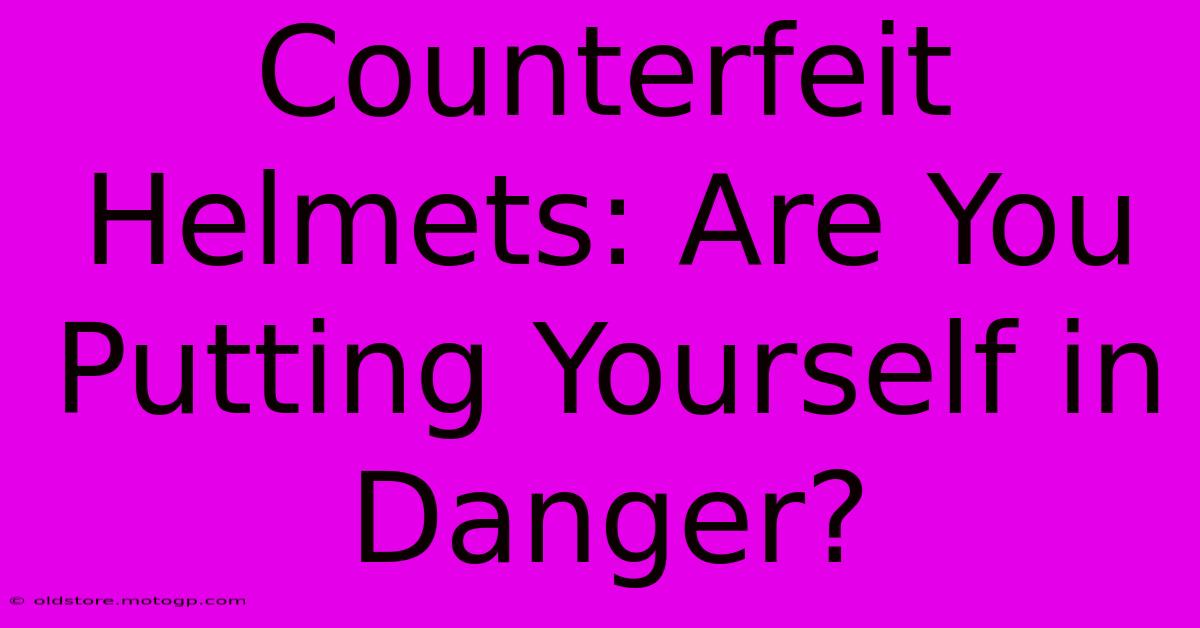Counterfeit Helmets: Are You Putting Yourself In Danger?

Table of Contents
Counterfeit Helmets: Are You Putting Yourself in Danger?
Are you risking your life for a bargain? The allure of a cheap helmet is undeniable, but the dangers of wearing a counterfeit helmet are far more significant than the savings. This article delves into the serious risks associated with counterfeit helmets and why choosing safety should always be your top priority.
The Deadly Truth About Counterfeit Helmets
Counterfeit helmets are often marketed as genuine products at significantly reduced prices. This deceptive pricing hides a dangerous reality: these helmets often fail to meet even the minimum safety standards. They might look the part, but their structural integrity is severely compromised. This means in a crash, a counterfeit helmet offers little to no protection, leaving you vulnerable to severe head injuries, including:
- Traumatic Brain Injury (TBI): A leading cause of death and disability, TBI can result in long-term cognitive impairment, physical limitations, and even death.
- Skull Fractures: Counterfeit helmets lack the necessary impact absorption capabilities, making skull fractures significantly more likely.
- Concussions: Even seemingly minor impacts can cause concussions in a poorly constructed helmet. The cumulative effects of multiple concussions can be devastating.
- Neck Injuries: Improper helmet design and construction can lead to whiplash and other serious neck injuries during an accident.
What Makes a Counterfeit Helmet Dangerous?
The materials used in counterfeit helmets are often substandard and lack the necessary strength and durability. They may use inferior plastics, weaker foams, or compromised fastening systems. This means the helmet's ability to absorb impact energy is greatly reduced, increasing your risk of injury.
Furthermore, counterfeit helmets often lack proper certification. Genuine helmets undergo rigorous testing to meet stringent safety standards set by organizations like DOT (Department of Transportation) in the US or ECE (Economic Commission for Europe) in Europe. Counterfeit helmets bypass these tests, offering no guarantee of safety.
Identifying a Counterfeit Helmet
Spotting a fake helmet can be tricky, but here are some key indicators:
- Price: If the price seems too good to be true, it probably is. Be wary of significantly discounted helmets, especially from unknown or untrusted sellers.
- Packaging and Labeling: Examine the packaging carefully for inconsistencies or poor quality printing. Look for misspelled words, grammatical errors, or blurry images. Genuine helmets typically have clear and accurate labeling with certification marks.
- Manufacturing Quality: Inspect the helmet for any flaws in construction, such as loose stitching, uneven paint, or poorly fitted components.
- Certification Marks: Verify the presence of authentic certification marks. These marks should be clearly visible and easy to identify. If you are unsure, check the manufacturer's website for images of genuine certification marks.
- Seller Reputation: Only purchase from reputable retailers and authorized dealers. Avoid buying from unknown online sellers or marketplaces with questionable reviews.
Protecting Yourself: Choosing a Safe Helmet
Investing in a genuine, certified helmet is the single most important step you can take to protect yourself. Your life is worth the investment. Here’s how to make a safe choice:
- Buy from Authorized Retailers: Purchase your helmet from reputable retailers or directly from the manufacturer to ensure authenticity.
- Check for Certification: Look for the appropriate certification mark for your region (DOT, ECE, Snell, etc.).
- Proper Fit: A properly fitted helmet is crucial for optimal protection. Have a professional fitting at a reputable retailer.
- Regular Inspection: Regularly inspect your helmet for any signs of damage or wear and tear. Replace it if necessary.
Conclusion: Safety First
The risks associated with counterfeit helmets are simply too great to ignore. Wearing a counterfeit helmet is not a gamble you want to take. Prioritize your safety and choose a genuine, certified helmet from a reputable source. Your health and well-being are invaluable. Don't let a false sense of economy put your life at risk.

Thank you for visiting our website wich cover about Counterfeit Helmets: Are You Putting Yourself In Danger?. We hope the information provided has been useful to you. Feel free to contact us if you have any questions or need further assistance. See you next time and dont miss to bookmark.
Featured Posts
-
Experience F1 Austin Like Never Before Shuttle
Feb 19, 2025
-
Cota Open Track Days No Experience Necessary
Feb 19, 2025
-
F1 Qualifying Todays Decisive Moments
Feb 19, 2025
-
Moto Gp Engine Technology A Revolution In Two Wheeled Performance
Feb 19, 2025
-
Understanding The V 4 Yamaha Engine
Feb 19, 2025
